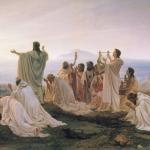I have mentioned in a previous post Patricia Terrell’s new reference work Paul’s Parallels: An Echoes Synopsis – a book that offers a nearly exhaustive set of tables comparing the entire Pauline corpus to various Biblical texts and also non-canonical literature.
I am pleased to share with you Dr. Terrell’s thoughts on the production of this work and its use in scholarship.
NKG: What brought your interest to such a major project?
PT: I looked for this book on the web and in-person at booksellers, university and seminary libraries throughout the U.S., England, Germany, France, and could not find it anywhere, concluding it did not exist. (Sadly, I did not know about the 1975 Francis-Sampley book.) Paul’s Parallels was an essential book for researchers so I made it a priority taking precedence over the project I was writing.
NKG: This book is quite detailed. Can you tell us how you went about discerning the parallels? What resources did you use?
PT: Years of diverse studies brought light to the proper interpretation of Paul’s parallels as well as knowledge of available resources. Church and academic development teach that one needs to read the Bible—with one’s heart and mind—to open one’s heart/mind/Soul to God’s purposes. In discerning the parallels, I began by reflecting on general precepts and questions:
- Consider what Jesus’ message(s) are.
- How was it transmitted to Paul, and then, by Paul [and the Apostles] to the churches? The history of the Holy Spirit, Paul’s encounter with the Resurrected Spirit of Jesus, missionary journeys proclaiming the Word of God and church planting church were recorded in the Acts of the Apostles. Therefore, Acts needed to be included in Paul’s Parallels.
- Are the reports in Acts about Paul’s dates and times of Paul’s missionary journeys consistent or variable with what we learn from Paul’s writings? Fitzmeyer presented the evidence in a table listing verses from Acts next to Pauline citations about places where he planted churches.
- How did Paul use his surroundings (culture and environment) at each missionary stop to teach Christian behavior? Study biblical archaeology and culture in Israel, Athens, Corinth, East-Greece (Turkey), and Rome. Include external non-canonical texts, like Josephus’ writings.
- At the crux of Paul’s missions were opponents. How would those who received the teaching sustain their own faith and support one another? Consider ways Paul’s Parallels may be utilized for professional and ministerial research and preaching as well as building the faith of contemporary readers. Show principles consistent through many societies.
- How does one measure authenticity in the midst of many religions or blurred cultural lines? Provide full citations of biblical resources for the reader’s full evaluation.
- Was there a method for teaching Christian behavior that naturally proceeds from the heart? Did Paul develop a system? Reflect on Paul’s Parallels as a vessel of Systematic theology. Consider the many types of research aided by a Pauline lens and address as many as possible (book purposes listed below).
- Paul and the New Testament look different when launched with a Pauline theology. He is a much more influential figure from a chronological perspective.
Biblical studies resources were used to organize tables. For example, Michael Greene, Wycliffe College, drew parallels between events in Paul’s life and Jesus’ life and I transferred his book information to tables. Bibles in the original languages with fragment notations were basics. Resources included, Throckmorton’s Gospel Parallels, Funk’s New Gospel Parallels, Vols 1 & 2, Kurt Aland’s myriad of references, concordances from KJV, NAB, NIV International, NASB and biblical commentaries. Online sites for Early Jewish Writings and Early Christian Writings and links we helpful.
The King James Bible (KJB) was the English translation or version (KJV) of choice since it was accessible while remaining closest to the original biblical languages, according to KJB experts, Alister McGrath, Laurence Vance, Herman Hanko, and numerous KJV experts. The KJV, with rights retained by the Crown of the United Kingdom, lends its 400-year old authenticity to this Pauline exposition. Her Majesty the Queen of England gave permission for its use by Cambridge University Press on Paul’s Parallels legal rights page.
NKG: How long did it take you to complete this work? Did you have help or did you do it solo?
PT: It was about 5 years from brain, PC, to the bookstore. In 2004, I began research and setting-up tables of parallels while fully engaged with experts’ research presented and debated at Oxford University’s New Testament Seminars (Faculty of Theology). Chris Rowland chaired and contributed greatly to the New Testament Seminars. During my years at Oxford, Chris Tuckett had several apt scholars translating and interpreting biblical studies discoveries that had not been given much recognition that was until Chris assembled a brilliant team.
When my reproductive ethics book (Counseling Pregnancy, Politics and Biomedicine: Empowering Discernment, NY/London: Routledge) was released at the June 2007 New York Book Expo, I discussed Paul’s Parallels with 4 publishers. Continuum brought a contract to the Society of Biblical Literature (SBL) 2007 annual meeting in San Diego. Paul’s Parallels was released at November 2009 SBL.
Paul’s Parallels was 95% Bible so the material may be attributed to the inspiration of the Holy Spirit. The generations of faithful Bible scholars that preceded its publication were my helpers. I physically compiled, organized, and wrote the data-biblical verses on the pages, without assistance.
NKG: How do you envision this aiding scholars, students, researchers, etc.?
PT: A researcher of a particular verse or pericope could look it up, cross-reference to related scriptures, and immediately decide which commentaries/authors to consult. By using this resource, the reader may discern a different or broader interpretation than he/she originally perceived by examining and contemplating the biblical verses of interest.
The following uses were the product of significant reflection and copied from the book:
- This is the first and only New Testament reference text featuring all of the Pauline and Pseudo-Pauline writings in the first column of a tables format cross-referencing parallel, echoing, and the most up-to-date translated like-minded biblical studies texts—side-by-side and cited in full.
- It is a desktop resource for theology teachers and professors, literary and early history researchers, ministry and seminary professionals, students of Christianity and biblical studies, as well as anyone researching the most written about personality in the biblical world—that is, the Apostle Paul.
- Until this book featuring Paul’s verses in the primary field, published comparative and formatted reference texts favored gospel verses as the focal point, in part due to the primacy of Jesus’ exemplary life, but also because scholarly interests during those decades held to the intrigues of synoptic comparisons. Mining synoptic textual similarities has many resources, but interests change and grow. One who was concerned about chronological matters while researching Paul, needed a more complete composition to study. Leading with Paul’s verses reveals that Paul worked through the challenges of “articulating the inarticulate” in full view of the apostles.
- This approach to scriptural research offers a new perspective to New Testament studies because Paul’s themes, his theology, his interpretation of Jesus’ teachings, and his imitation of Christ become an independent focal point and, from this book, it is clear he influences a sea of later writings, including the gospels and copyists.
- New research, theses, dissertations, books, articles, and literature of all types will result due to this new perspective featuring Paul’s initiating influence. Extracting Paul’s verses from the “opponents theses” in which much of the writing is cast, allows Christian themes to breathe. One may view Paul as a natural person who is in the process of being converted from a rough, legalistic, religious personality into a little Jesus (also seen in Luke’s “Acts”).
- This book liberates Paul from positioning behind the gospel writers so researchers can study ways in which Paul shaped gospel scholarship [because he wrote before the evangelists]. This reference book cites Paul first and lets chronology speak for itself.
- Paul made scholarly contributions to the gospel writers, which can be tested through this material. The educated Jewish Pharisee, Paul, showed the gospel writers, which Jewish material mattered and ways to organize it.
- Paul informed and interpreted Holy Mysteries for the evangelists and these can be teased out using this book. Paul’s life, ministry, revelatory faith experiences, and their articulation preceded gospel authorship. Paul taught the evangelists how to better express Jesus’ demonstration of the Holy mysteries through his own enlightenment.
- A theme is annunciated for each verse and its biblical compliments to guide the reader and keep him/her focused on the subject.
- The tables format points out the major themes Paul makes use of in converting the Gentiles throughout his missionary journeys—these are plain and repetitive. Professional missionaries can be reassured of their methods and current activities in light of Paul’s missionary activities as guided by the Holy Spirit.
- This book is a seminal reference text for teachers, professors, students, theologians, seminarians, religion teachers, pastors, ministers, priests, and any biblical studies researcher.
- Every student and researcher of Pauline and Pseudo-Pauline literature has the fingertip ability to see how verses relate to one another and the frequency of citation.
- Theology teachers and students as well as ministers preparing sermons have a clear reference about where Paul’s life and ministry echoed Jesus’ own experiences, without having to backtrack from the gospel parallels – to find the Pauline precedents.
- Readers can quickly view the biblical sources that supported Paul’s proclamations [from whom/where he derived his positions].
- The reader can see who cited Paul, including ardent pseudo-Pauline enthusiasts and, perhaps, the evangelists who wrote the gospels much later than Paul.
- Pseudo-Pauline texts quickly show cross-references to Paul’s original recitations –and other supporting resources.
- Theologians and ministers can easily and competently organize Paul’s words and events into a more reliable historical sequence (Paul’s epistles were sequenced by length, not date). Corinthians and Philippians were composed of fragments from differing time periods; this resource recognized the project must be done carefully and with integrity, examining each verse. The format offers researchers more opportunity to organize Paul’s texts into a historical sequence because Paul’s verses and themes are independent.
- The researcher who energetically endeavors to sequence Paul’s spiritual growth, Christian awareness, and transformation will find this reference invaluable in developing a more accurate timeline of Paul’s experiences and psychological development—research with credibility.
- The reader can develop new Pauline systematic theology techniques using this resource.
- This reference text allows the reader to explore the impact Paul made upon the gospel writers and his co-workers in Christ.
- This book relieves the researcher of laboriously searching through concordances and biblical notes to cross-reference Paul’s verses with supporting information.
- The book is intellectually and linguistically accessible using the King James translation because KJV is closest to the original Greek New Testament writings, according to KJV experts Alister McGrath, Laurence Vance, Herman Hanko, and others.
- Preachers see the Christian experience through Paul’s eyes, as one who imitated Jesus’ lifestyle, encountered God, and wrote about the resulting events – this creates many new preaching possibilities.
- This reference text has a universal audience for those interested in the Bible and the Apostle Paul. Like all biblical resources, accessibility to this material depends on its translation into other modern languages
NKG: Non-canonical parallels could be sought out endlessly – how did you know where to start, and when to stop?
PT: You are so right, the research of non-canonical parallels by notable New Testament scholars was extensive and continues to proliferate and flourish. Paul’s Parallels admitted information by long established sources.
The Q-Quelle source, on the other hand, had nearly zero Pauline development so, out of curiosity, I worked backwards to see how it would go. A Quelle group was placed in a Paul table only when there was evidence of at least 2 gospel citations that matched the claims of the Q experts. Q theorists have steered clear of citing or pairing principles from Paul so all I could do was put it out there for further exploration. Q needed to be included, where possible, to draw upon its value in a Pauline perspective.
Before the Q theory was postulated, synoptic parallels were presumed to be a product of the accountability required of one so charged with reciting sacred oral tradition; oral tradition meant using exactly the right words from the Jewish Talmud and Logos-Word traditions. Factually, Paul was a friend of the apostles. They prayed together, had tea, discussed their faith, shared Christian experiences, and discerned plans for mission. Paul was a physical common denominator between exact and similar biblical citations used by and between the evangelists.
NKG: Did you learn anything particularly about Paul and the nature of his letters once you had completed this project? Having the knowledge that you have, and having seen so many connections and “echoes,” what do you take away from this reference project?
PT: Hearing the gospel truths-scriptures in Paul’s voice and reading Paul’s letters through his lens helped me recognize Paul’s contribution as much greater than previously. Indeed, he preceded the gospel writers. And, of course, Paul was educated by the best Jewish teacher of his time, so his writings extended beyond boundaries of time and place—backward and forward. Paul taught me to articulate my faith just as he did the Apostles and church audiences. Paul taught the Apostles how to craft their presentation and witness of Jesus’ life in cooperation with the Holy Spirit’s inspiration. He was a gardener of God’s Words. The Bible and Paul’s presence in it are palpable. It is hard to put a finger on it, but he looks different to me after completing this project.
Paul’s spiritual formation shows through his letters. He struggled with issues and his own personality quirks, but he used experience to offer behavior standards as a guideline for how we are supposed to be and behave in the natural—and in love of Jesus.
Paul discussed mysteries of which we need to be aware, such as being “caught up into the third heaven,“ so when this happens to us, we give thanks for the immense blessing and ponder more deeply how we may serve God. I am very grateful for Paul’s witness and corroboration of the activities of the Holy Spirit. I am keenly aware of Jesus’ reflection in the face of others and the way my words and actions may teach, heal, and enlighten faith.
NKG: Can you share with us any other writing projects you are working on for the future?
PT: I am researching a type of commentary, a companion text for this, with co-authors.











